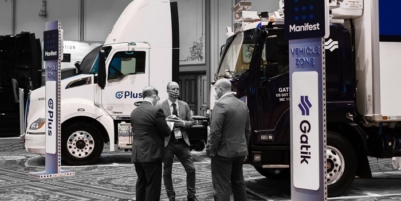-
Nutrivend selects Forterro’s Orderwise to support online expansion and streamline operations - April 11, 2025
-
ARROWXL LAUNCHES AMBITIOUS ZERO WASTE ROADMAP - April 8, 2025
-
THE BCMPA’S NEW CAMPAIGN DRIVES OUTSOURCING SUCCESS IN Q1 - April 7, 2025
-
BLACKOUT TECHNOLOGIES TARGETS TELEMATICS-INTEGRATED MOBILE DEVICE BLOCKING TO COMBAT SMARTPHONE DISTRACTION - April 1, 2025
-
Sparck Technologies awarded Royal designation - March 27, 2025
-
OpenADR Alliance announces first OpenADR 3.0 certified products with EVoke Systems, E.ON Energy and Universal Devices - March 25, 2025
-
Growing fulfilment and contract packer appoints new Managing Director - March 25, 2025
-
When is it time to invest in a WMS? Understanding the key trigger points - March 25, 2025
-
eCapital helps Vantage Recruitment on its journey to financial success - March 24, 2025
-
Hugo Beck Celebrates 70 Years of Packaging Innovation with Open House Events - March 20, 2025
The Coronavirus pandemic has created business challenges and opportunities alike, but how will it impact the future of supply chain recruitment? Read our latest insights to explore…
By Leigh Anderson, Managing Director, Bis Henderson Recruitment
When 6.3 million employees are on furlough, and 2 million have joined the ranks of the unemployed, it may seem perverse to suggest that a major issue for the recovery will be the recruitment and retention of staff.
Having the right level of staffing, with the appropriate blend of skills, abilities and attitudes, is a strategic issue in itself, and because only with appropriate staffing can other strategies be implemented. That is truer than ever as firms fight through, and hopefully out of, the Corona-induced recession.

Companies whose strategies have been stable for years are now planning and implementing wholly new approaches in novel environments. More business activity may move online; distancing and the need to get more productivity from a reduced number of staff on site may accelerate automation and digitisation trends; business may become more collaborative with partners and in some areas even with competitors. New skillsets will be required, from the operator level right up to the executive and Board.
And even if most of those skills were present in the pre-lockdown workforce, how many of those that have been made redundant will be queuing up to re-join an employer that has, however reluctantly, ‘let them go’? How many of those working from home are disinclined to go back to the office? How many on furlough have re-evaluated their career goals and life plans? There will be those who are reluctant to return, because they are in recognised high-risk groups. Among those who have stayed at work, there will be cases of ‘burn-out’. Firms should be planning and acting now, through recruitment and retraining, the skills they will depend on in the recovery.
Key to rebuilding the workforce will be to devise, implement and communicate a robust and effective ‘return to work’ plan that creates confidence by anticipating and assuaging the concerns of current and future employees.
The logistics sector poses particular risks: many operations are labour-intensive, with a lot of movement, much common-user equipment, and many interactions and touch points. People who are ill shouldn’t be coming to work, and there needs to be a culture within which workers do not fear being penalised for doing the right thing. Fast, affordable contactless temperature checks are within reach. Importantly, these checks, and indeed all the other measures, must be seen to apply not just to staff, but to visitors to the site too.
The employer must provide, instruct on and enforce the use of suitable, fit for purpose PPE wherever required. That includes situations where workers feel the need, even if objectively there is little or no risk. PPE also includes sanitisers and washing/cleaning facilities, both personal and for shared equipment such as keypads, terminals, lift truck controls and the like. Shared use of personal equipment such as headsets and other wearable items, and hot-desking, should be strictly avoided.
Keeping a distance
Staggering start and finish times reduces congestion and also can help spread peaks on public transport, likely to be a major disincentive to returning to work. Making car and bike parking easier will also help here. It may be possible to introduce one-way flows. Office staff will need to be ‘spread out’ more. Face-to-face meetings can be curtailed and some staff can continue to work remotely.
Washrooms are problematic – usage may increase with a culture of frequent hand washing. Guidance also suggests that staff should change in and out of work clothes and uniforms at the place of work rather than at home.
Firms also have a duty to provide for the needs of visiting drivers and the like: but there is obvious scope for resentment if it is felt that such visitors pose an additional risk. Canteens too are problematic: employees have to eat. Break times will need to be carefully planned and, as elsewhere, clean-down regimes increased.
Another very difficult situation is that of training. While classroom-based training can be delivered remotely, learning most tasks does at some stage involve direct interaction. Facilitating this will require care.
Down on the floor
Although, particularly in the more automated sites, the average distribution of employees allows for very satisfactory social distancing, there are places where people do gather in close proximity. Technology can be our friend here.
Queues around terminals can be addressed by a greater use of hand-held and wearable devices. These are becoming increasingly affordable, and as personal equipment they solve many of the contamination problems of multi-user keypads and the like.
At the pick face, many warehouse management systems (WMS) can be set to minimise conflict and congestion. Consider changes in picking strategies. In some instances, wave picking or zonal picking can greatly reduce the number of encounters on the floor. Longer term, a move from person-to-goods, to goods-to-person picking may achieve similar results. On many sites the greatest density of employees is around pack and despatch. This is a specific example of a general truth: the highest densities of employees are probably around the system bottlenecks, and it is here that the greatest return on automation investment is likely.
New tricks
All the above gives rise to a need to realign the skillsets of the workforce, through retraining or recruitment. Some roles will increase in number and importance; some new roles will be created.
Moves towards automation will require technical skills – programmers, maintenance engineers – but also managers who understand how to integrate automation with existing manual processes and have a vision of where it can be most effective. Supply chains are likely to be more volatile – procurement skills may need to be more relational, less transactional. Across the board, while successfully implementing ‘the plan’ is still of course key, there will be a greater premium on managers who can devise and pivot to alternative plans, at speed.
Some requirements are more specific. If remote/home working is to be a permanent feature, skills will be needed to manage this, and to support the tech needs of remote users. Health & Safety, with emphasis for once on Health, has renewed importance. Firms may need more H&S staff to devise and implement safe practices and these may be practical enforcers at site level, not policy generators at Head Office. So people skills will be just as important as knowledge of best practice. At another level, additional cleaning may be required, involving new or repurposed staff. Cleaning, especially around complex, expensive and sometimes hazardous equipment, is not a low-skill task – the effort needs planning, training and management.
A time of opportunity
Businesses may also choose to bring forward changes that were being contemplated anyway, and this may have staffing implications. If a company is to make big moves or investments this is as good a time as any. For firms operating below capacity changes can be introduced with less disruption. Automation prices have become very reasonable, money is as cheap as it will ever be, and rental and leasing solutions are emerging.
For companies that have worked out their forward-looking skills needs and strategies, this may paradoxically be an excellent time to enter the recruitment market. There are many highly skilled people (at every level from lift truck operators to supply chain directors) who through no fault of their own are without a position. There will be many more who have had the opportunity to reconsider both their career goals and their current employer and would relish new challenges.
One should not, though, neglect the opportunity to identify high-performing individuals in the current workforce, with a view to retraining, repurposing or promoting them. There will be those, at all levels, who have been enabled during the crisis to display unexpected qualities – leadership, initiative, thinking outside the box – beyond their pay grade and who would repay investment. Equally, though, if these qualities are not recognised, good staff may walk at the first opportunity.
It is possible though that a workforce, already feeling insecure, may view automation and other changes as a further threat. That brings us back to the central importance of communication. Firms need to be continually communicating with their current staff and with potential recruits, telling them about the problems faced, involving them in designing processes that work for them in the real world, showing them how the solutions work, what is expected of them and what they can expect, and what support is. Create confidence through communication and logistics firms will succeed in recruiting and retaining that most valuable commodity – the staff.
In summary
Above all, we will need agile and progressive managers who can manage in a way that no-one has managed before – remotely but compassionately, and ready to change direction very quickly.
Bis Henderson has seen the supply chain sector through numerous stages of its evolution; from High Street to Internet, from Paper to Handheld, from Spreadsheets to Blockchain. This next era whilst daunting, may just herald the most exciting changes in supply chain recruitment since the emergence of the Web.
If you need support in adjusting your people strategy as we transition out of lockdown and into a ‘post-COVID’ world, Bis Henderson Recruitment can help.
Leigh Anderson is Managing Director of Bis Henderson Recruitment.Contact us on 01604 876 345.
More on Bis Henderson Recruitment: www.bis-hendersonrecruitment.com
































